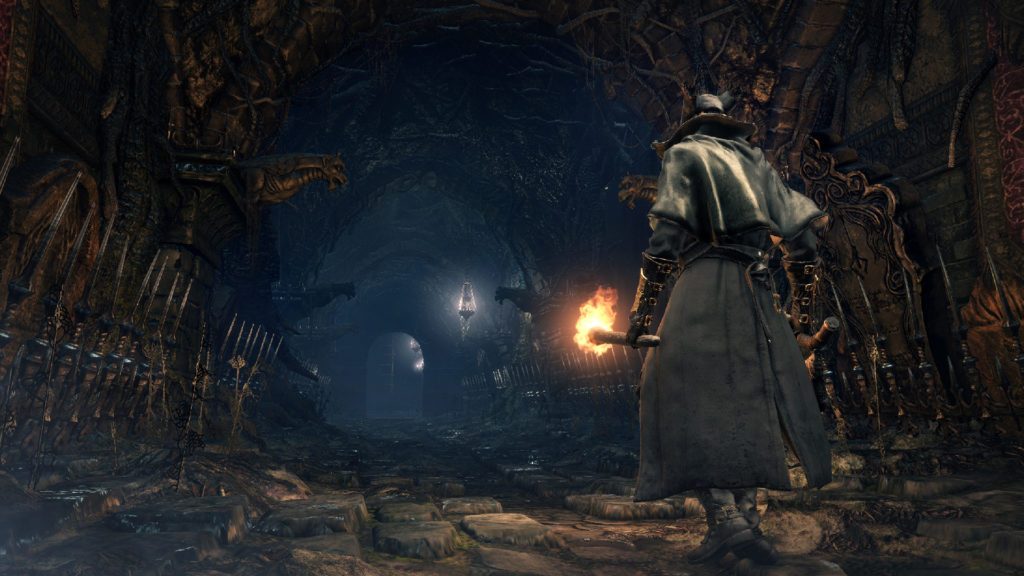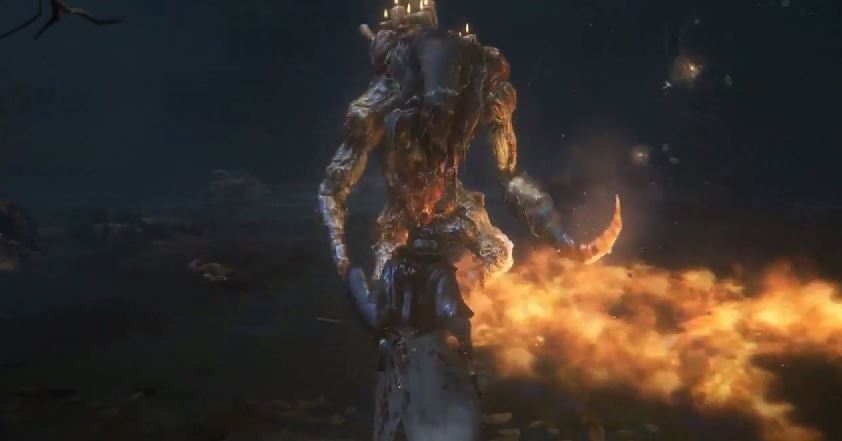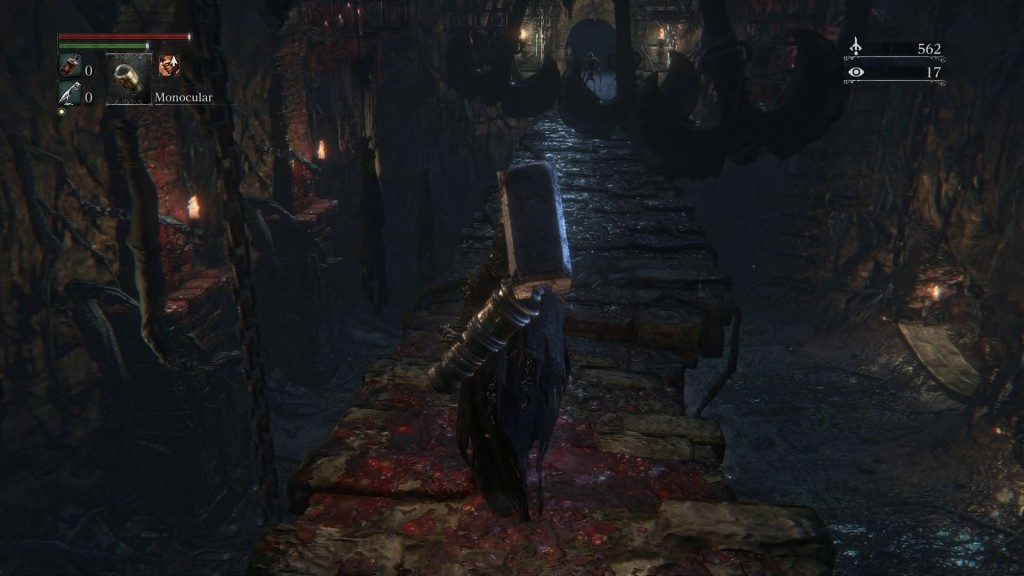Chalice Dungeons are one of the most pleasant surprises in Bloodborne…provided you actually do them!

The whole process begins after you defeat the boss (Blood-Starved Beast) of an entirely optional area (Old Yharnam). Killing this foe yields an item, the Pthumeru Chalice, which you use to conduct a Chalice Ritual. Said Chalice Ritual requires a tombstone located in The Hunter’s Dream; once you actually figure all this out, the Chalice Dungeon system finally opens up to the player. It goes without saying that, in some sense, we can say From Software hides most of the Chalice Dungeon chalices in optional areas as a distinct path unto itself from the main linear game. As far as I can tell, you’re supposed to do each dungeon when you receive its corresponding chalice, since you tend to out-level enemies otherwise. Think of it as a break from the main game, some optional content.
And my goodness, is it ever a lot of optional content. Chalice Dungeons are filled with enemies that never even appear in the main game, from regular enemies to bosses. Seriously, entire bosses are simply locked from the player who doesn’t do Chalice Dungeons at all, which surprised me greatly! Of course, these areas do look a lot like interconnected square rooms and hallways a lot of the time, but considering the fact that you can randomly generate new ones once you obtain the appropriate chalice, that softens the blow a bit. Regardless of the aesthetics of such places, there’s literally half a game here that most people will never explore – and by the time they do, they’re going to plow through these new challenges without breaking a sweat. Unfortunate!

Anyway, to describe how this work: Chalice Dungeons are best described as a series of mazes, a labyrinth of tricks and traps, hidden objects, and lots of Souls-style combat situations. You explore them just like any other area in the game, with the requisite slow-pacing and lots of hidden objects. You’re incentivized to explore, mostly because unlocking the next Chalice Dungeon requires it; most of the Chalice Rituals require crafting materials which pop up in the dungeons, so finding everything will prove to eliminate the grind a bit. Still, that’s a lot of area to traverse, but it’s more in bite-sized and focused form than most Souls games. I like to think of them as little challenge rooms, which is a cool and new idea for the Souls series. If they don’t want to make a Boss Rush mode, something like this will certainly do!
The cool part, though, isn’t the fact that these exist (and that there’s a lot of them). The neat part is the randomly generated Chalice Dungeons. This sounds like the silliest idea ever for a series that emphasizes hand-crafted, well-paced level design above all else. How do you make areas with random generation that could ever equate to the stellar, interconnected worlds of a Souls game? Apparently, it’s not as difficult as you think, provided you have enough limiting factors to make sure the level turns out well. It dawned on me that the relatively staid aesthetic design (i.e., a maze!) turns out to allow for a variety of level layouts, and there’s enough room diversity (with whatever enemy combinations chosen) that it almost always proves to be a delightful challenge.

All of this surprises me because I usually hate random level design with a passion. I am sure you’ve seen almost no games involving such mechanics on Theology Gaming, primarily because I think it’s lazy and defeats the purpose of playing a video game on some level. If I’m going to pay money for a video game, I want a level that somebody put some work into at a very deep level, understanding the player and their predilections. I want a game designer to nudge me in the right direction, and make me feel smart like I figured something out – despite that being his/her intention all along! Usually games with randomly generated content fail on this level, both in making for a “fair” game and also in lacking a certain sense of guided experience.
And yet, Chalice Dungeons work. They never feel random, and that’s an important point. I think, though, that’s there is a balance here that restricts the possible combinations that can occur in any one room or dungeon structure. Clearly, a lot of work went into the preset Chalice Dungeons – I would guess they were the best and most accessible results from the system they devised. From there, the random Chalice Dungeons are determined by the strength of the crafting materials used to make them and the kind of themed chalice used (Pthumeru brings different hazards and enemies than Hintertomb, just for example). There’s a lot of design already happening here, but it’s being configured in interesting ways for players who want to exacerbate the challenge. And, of course, you can play some particularly nasty dungeons that other people happened upon, provided you know the appropriate code for them.

All of this usurped my expectations for randomly designed content; Bloodborne’s combat, solid as it is, provides an excellent backdrop for new and surprising situations that emerged from a tightly-wound set of rules in Chalice Dungeons. And somehow, this feature didn’t make it into Dark Souls III in some way, shape, or form, which absolutely baffles me on so many levels. This is good stuff, and yet I dare say I’ve not read a single review mentioning it in any great detail, or bothering to tell the reader how much original and new content is there. From Software does like to hide content deep within their games to the point where you need the collective Internet to figure it out, but these were a highly touted feature before release that nobody seems to care for.
I guess I just like discovering new things, really. This sense of genuine surprise is not something I’ve found often in video games, but here we are! Sometime it takes a slight variation on something, a twist, or turning something on its head to make it more enjoyable or more meaningful. In the same way that Jesus turned the Law on its head by fulfilling it, so too are video games which turn your preconceived notions on their head a delight. It may not look like something you want to try at first, but game designers know best…right? At least in God’s case, we know it works!
38 “You have heard that it was said, ‘An eye for an eye, and a tooth for a tooth.’ 39 But I say to you, do not resist an evil person; but whoever slaps you on your right cheek, turn the other to him also. 40 If anyone wants to sue you and take your [a]shirt, let him have your [b]coat also.
Matthew 5
